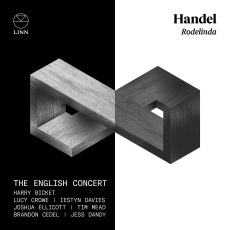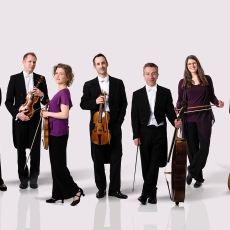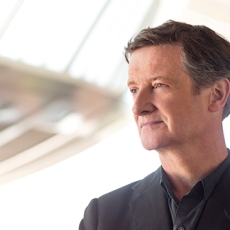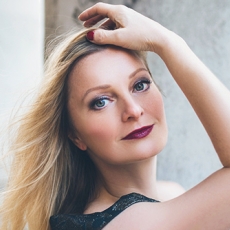The English Concert - Handel: Rodelinda - Voix des Arts
Few periods in human history are as universally associated with the work of a single artist as the first half-century of the United Kingdom’s Hanoverian dynasty is with the music of Georg Friedrich Händel. Just as the 1714 death of Queen Anne left the British throne without a direct-line occupant, the untimely demise of Henry Purcell in 1695 deprived English music of its foremost talent, initiating a time of transition during which there was no native-born composer whose gifts earned universal acceptance as those of Purcell’s rightful successor. The 1701 Act of Settlement that denied Catholic claimants a path to Britain’s crown by recognizing scions of the German-speaking Haus Hannover as Anne’s heirs presumptive was not concerned with culture, but its implications could not have affected music in England more profoundly.
When the Hanoverian Elector Georg Ludwig was crowned as Britain’s King George I on 20 October 1714, Georg Friedrich Händel—Georg Ludwig’s Kapellmeister in Hannover since 1710—was already familiar in the refined musical circles of the English capital, where his opera Rinaldo, the earliest known opera in Italian that was composed for performance in Britain, received a rapturous welcome in 1711. This good fortune and a favorable reception from England’s nobility persuaded Händel to relocate to London, where he quickly courted aristocratic and royal patronage, the latter initiated by a generous stipend awarded by Queen Anne. Five years after his former Hannoverian employer’s ascent to the British throne, the financial backing of a consortium of titled gentlemen and the issuance of letters patent by the crown enabled Händel to establish his first Royal Academy of Music, the institution via which the composer, who became a naturalized Englishman in 1727, dominated opera in the United Kingdom for a decade.
Händel was unquestionably an opportunist who realized that the most important rôle in any opera production is that of the guardian of the purse strings. Händel’s operas often contained scenes and characterizations that Eighteenth-Century Londoners could not have failed to identify as flattery designed to appeal to influential figures’ vanity. Fêted egos reliably yielding fiscal support, the Royal Academy’s stagings were frequently populated by crowned heads, martial heroes, and long-suffering spouses whose virtues mirrored those attributed to deep-pocketed pillars of English society.
For the Royal Academy’s first new offering of 1725, Händel selected a tale of a faithful wife and mother who, erroneously believing her husband to have perished in exile, is relentlessly pursued by a libidinous usurper whose villainy encompasses leveraging a child’s life. Adapting a libretto by Antonio Salvi that was set by Giacomo Antonio Perti in 1710, Nicola Francesco Haym provided Händel with a scenario rich in possibilities for celebrating the much-prized virtues of valor and uncompromising connubial fidelity. The quality of his music for Rodelinda, regina de’ Longobardi illustrates that, its potential for increasing the Royal Academy’s stature notwithstanding, this story of misadventures and perceived betrayals appealed deeply to the famously cantankerous Händel.
First performed at London’s King’s Theatre in the Haymarket on 13 February 1725, Rodelinda reached the stage only three-and-a-half months after the première of Tamerlano and slightly less than a year after the inaugural production of Giulio Cesare in Egitto. The success of Tamerlano in October 1724 was sufficient to convince Händel of the commercial viability and artistic perspicacity of entrusting the rôles in Rodelinda to the singers who created parts in Tamerlano. The titular queen of the Lombards and her absent consort were therefore first interpreted by two of Eighteenth-Century London’s most popular singers, soprano Francesca Cuzzoni and castrato Senesino, whose portrayals of Asteria and Andronico were vital components of Tamerlano’s triumph. The parts of the scheming Grimoaldo and Garibaldo were taken by Tamerlano’s Bajazet and Leone, Francesco Borosini and Giuseppe Maria Boschi, with Anna Vicenza Dotti and Andrea Pacini, the first Irene and Tamerlano, as Eduige and Unulfo. Händel’s strategy proved to be prescient: introduced by this ideally-qualified cast, Rodelinda became one of the Royal Academy’s longest-running and most-revived works.
Regrettably, Rodelinda has not been as fortunate on recordings as it was on the London stage in the years between its 1725 première and Händel’s death in 1759. A pioneering production of the opera in 1920 occasioned German radio performances of truncated versions of the score that now offer glimpses of how Baroque opera fared prior to the renewal of interest in historically-appropriate performance practices. Handel Opera Society’s 1959 performances at Sadler’s Wells featured singers of the proper registers in all rôles, the young Joan Sutherland and Janet Baker among them, but neither this nor the first complete studio recording in Italian—a lovely performance with particularly fine singing by Maureen Forrester and Helen Watts that has never been formally available on CD—takes full advantage of advances in scholarship. Despite the participation of an ensemble of renowned singers and the use of Haym’s Italian text, Sutherland’s egregiously-cut late-career studio effort is markedly less effective than the 1959 production, and subsequent audio and video recordings of varying provenance achieved greater authenticity without producing a Rodelinda of indisputable superiority.
Under the direction of Harry Bicket, whose rendering of the continuo is reliably propulsive but gratifyingly modest in when it could be distracting, Linn Records’ Rodelinda proves to be a rare recording without weaknesses in casting, conducting, or orchestral playing. Recording a complete opera whilst adhering to pandemic-imposed distancing protocols is a fearsome prospect, but the intimacy of many of the characters’ exchanges in Rodelinda make recording this opera in studio intimidating in the best of times. Aided by assistant engineer Rodrigo Leal del Ojo and the post-production work of Julia Thomas, Linn’s producer and engineer Philip Hobbs effectuated a recorded ambience in which Händel’s music drama plays out as in a staged performance but with clarity that is rarely possible in an opera house, details of text and instrumentation always audible but never unduly accentuated.
To a markedly greater degree than in many studio recordings of Baroque operas, rhythms in this Rodelinda unerringly follow the course of the drama, stirringly taut in scenes of confrontation and defiance and affectingly expansive when sorrow and regret inundate the music. Physical distance separated the English Concert musicians during recording sessions, but the precision of their ensemble playing discloses unvarying unity of purpose. Obbligati are reliably virtuosic but also congruous with the singers’ phrasing of corresponding vocal lines. The art of fruitful collaboration is an element of professional musicians’ training, yet the continuity of this Rodelinda indicates that the spirit of community demonstrated by these musicians in the making of this recording was not merely an act of professionalism.
Responding to Bicket’s intuitive handling of the score, a noteworthy accomplishment of which is the selection of tempi that are faithful to the composer and his characterizations, the instruments and their players become participants in the drama, their sounds interacting with the voices with a rapport expected in performances of music by Wagner and Richard Strauss but heard all too rarely in Händel’s operas. Months of isolation and cancelled performances perhaps fostered inwardness that nurtured the English Concert’s connections both with one another and with the music. Amidst its devastating losses, the pandemic was the catalyst for a superb Rodelinda.
In performances that heed his instructions and utilize uncut editions of his scores, there are virtually no inconsequential or thankless rôles in Händel’s operas. There are of course numerous instances in which music was written or rewritten to suit particular singers, but even these acts of musical necessity serve legitimate dramatic purposes within their proper contexts. In the context of this recording, the performance of the rôle of Bertarido’s loyal courtier Unulfo by countertenor Tim Mead contributes invaluably to the musical integrity of the English Concert’s Rodelinda.
Setting a standard that is matched by his colleagues, Mead’s declamation of secco recitatives is appropriately conversational, unwaveringly musical, and driven by clear, unexaggerated diction. His singing of Unulfo’s aria in Act One, ‘Sono i colpi della sorte per un’alma,’ reveals great affinity for capitalizing on the emotional undercurrents that flow through Händel’s vocal writing. The voice attractive and evenly-projected throughout the range, Mead’s technical assurance facilitates performances of the arias in Acts Two and Three, ‘Frà tempeste funeste a quest’alma’ and ‘Un zeffiro spirò, che serenò quest’alma,’ that credibly depict contrasting facets of the level-headed Unulfo’s personality, lending him greater depth and involvement in the drama than he sometimes wields. Stating that a minor rôle benefits from a performance by a major singer is clichéd, but Mead’s portrayal of Unulfo legitimizes the platitude’s veracity.
The duplicitous Garibaldo, whose lust for power robs him of the most basic tenets of decency and decorum, is enlivened with adroit vocal acting and unabashedly flamboyant singing by bass-baritone Brandon Cedel. Garibaldo is a rôle in which Samuel Ramey excelled, and, though their voices are very different instruments, Cedel shares his predecessor’s dedication to heightening the character’s menace by making him luridly seductive. The flinty edge and scornful inflections of Cedel’s singing of recitatives banish any questions concerning this Garibaldo’s intentions. His account of the aria ‘Di Cupido impiego i vanni’ in Act One pulses with the sinister glee of a man who rejoices in his machinations.
Cedel also evinces the cowardice that cowers behind Garibaldo’s machismo façade, emphasizing the irony of the schemer’s bravado giving way to alarm at Rodelinda’s vow to pave her road to the throne with his severed head. In Act Two, he voices ‘Tirannia gli diede il regno’ impactfully, the voice’s steely glint reflecting the meaning of the words. Despite his depravity, Cedel’s Garibaldo is not devoid of suavity, his fiorature executed smoothly and descents below the stave focused without being forced. In Cedel’s performance, wickedness sounds irresistibly sensual.
True contraltos are no more common in opera than to-the-manner-born Brünnhildes and Isoldes. There is hardly an overabundance of rôles for contraltos in the works that populate the international repertory, but Händel’s operas and oratorios contain wonderful parts for low-voiced ladies. In this Rodelinda, the contralto rôle of Bertarido’s sister Eduige, the target of Garibaldo’s treachery, is sung by Jess Dandy, whose refined vocalism recalls that of the esteemed Alfreda Hodgson. Dandy’s singing of Eduige’s Act One aria ‘Lo farò, dirò spietato’ suggests that her bravura technique, though impressive, remains a work in progress. Dramatically, she is wholly on point, convincingly imparting concern and contempt. Her account of ‘De’ miei scherni per far le vendette’ in Act Two bristles with indignation, her vocal colorations shifting with the passions of the text. The aria in Act Three, ‘Quanto più fiera tempesta freme,’ is sung with irrepressible tenacity, this Eduige proclaiming that she is a pawn in no one’s game. The theatricality, integration of registers, and tastefulness of Dandy’s singing are delightful and promise still greater things.
Whereas almost no virtues mitigate Garibaldo’s iniquity, the actions of the crown-stealing Grimoaldo are extenuated to some extent by an earnest if somewhat masochistic infatuation with Rodelinda. Vestiges of unfeigned affection are audible in tenor Joshua Ellicott’s complex, conflicted portrayal of Grimoaldo. Without neglecting the ferocity at the core of Grimoaldo’s subterfuges, his singing conveys unexpected fragility. The first of his arias in Act One, ‘Io già t’amai, ritrosa,’ is voiced with bemused vehemence. Ellicott’s Grimoaldo is an ancestor of Richard Strauss’s Herodes and Aegisth who deploys ‘Se per te giungo a godere’ like a conniver’s credo, the tenor’s penetrating timbre sharpening the words’ subversive edge
In Act Two, Ellicott’s assertive manner of singing divisions complements the forthrightness with which he makes dramatic points, the most challenging passages of Grimoaldo’s music thereby tellingly differentiated from the part’s gentler pages. He sings first ‘Prigioniera hò l’alma in pena’ and, later in the act, ‘Tuo drudo è mio rivale, tu sposo’ with close attention to the ways in which Händel’s vocal writing advances the character’s psychological development. Vividly intelligible in every scene in which he appears, Ellicott’s diction galvanizes this Rodelinda’s dramatic electricity in Act Three, baring Grimoaldo’s competing emotions in ‘Trà sospetti, affetti, e timori.’ Moreover, the tenor’s enunciation of the accompagnato ‘Fatto inferno è il mio petto’ blends a Lieder singer’s textual acuity with a stage actor’s deft management of the interweaving of public and private sentiments. Ellicott’s contemplative voicing of Grimoaldo’s final aria, ‘Pastorello d’un povero armento pur dorme contento,’ resolves a probing musical character study of a man whose ambition is undermined by love. Ellicott affirms that, in order to be effective operatic antagonists, harsh characters need not be sung with harsh tones.
Like many of the rôles composed by Händel for Senesino, the deposed king Bertarido vents his strikingly timeless feelings of love, disappointment, and anger in music that pits outbursts of vengeful coloratura against passages of heartrending lyricism. It is with an exquisite example of the latter that Bertarido is first introduced in Act One, and in this performance countertenor Iestyn Davies seems not so much to sing the accompagnato ‘Pompe vane di morte’ as to live the king’s horror and sorrow at seeing his own funerary monument. The sustained B with which he begins ‘Dove sei, amato bene’—justifiably one of Händel’s best-known and most-loved arias, now and in the Eighteenth Century—pierces the hearts of both the character and the listener, the allure of the sound intensifying the pain and yearning that it expresses. Contemporary accounts unreservedly praised Senesino’s singing of Händel’s introspective arias, but, sung in this performance with beauty and expressivity matched on recordings only by Dame Janet Baker, ‘Dove sei, amato bene’ might have been composed for Davies. He brings equal authority to ‘Confusa si miri l’infida consorte,’ however, acting with the voice to limn the despair and desperation that seize Bertarido when he believes that Rodelinda has chosen a crown over fidelity to her husband’s memory.
As Bertarido’s fortunes unfold in the opera’s subsequent two acts, Davies continually adapts his vocal shading to fit the quicksilver progress of the drama. Both of Bertarido’s arias in the second act, ‘Con rauco mormorio piangono’ and ‘Scacciata dal suo nido sen vola,’ are splendidly sung, and Bertarido’s lines in the duetto with Rodelinda, ‘Io t’abbraccio, e più che morte aspro,’ receive from the countertenor readings of tremendous eloquence. In this performance, the Act Three scene in which Bertarido voices ‘Chi di voi fù più infedele, cieco Amor’ is gripping, and the aria ‘Se fiera belva ha cinto frà le catene’ is ardently but stylishly sung. Davies’s voice is a soft-grained instrument that woos more compellingly than it wages war, but he sings the turbulent aria ‘Vivi, tiranno’ commandingly, the roulades executed rousingly. After this display of vocal prowess, the duetto with Rodelinda ‘D’ogni crudel martir’ could seem anticlimactic, but every note that Davies sings in this performance is momentous. Davies’s preeminence as an interpreter of Händel’s music has been widely acknowledged for longer than a decade, but his portrayal of Bertarido in this Rodelinda is a marvel of Händel singing with few recorded peers.
With the rôles that he composed for Francesca Cuzzoni [in addition to Rodelinda, Teofane in Ottone, re di Germania, Emilia in Flavio, re de’ Longobardi, Cleopatra in Giulio Cesare in Egitto, Asteria in Tamerlano, Berenice in Scipione, Lisaura in Alessandro, Antigona in Admeto, Costanza in Riccardo primo, re d’Inghilterra, Laodice in Siroe, re di Persia, and Seleuce in Tolomeo, re d’Egitto, as well as Polissena in the 1728 revision of Radamisto], Händel inaugurated a tradition later expanded by bel canto composers’ parts for Giulia Grisi, Maria Malibran, and Giuditta Pasta and by Verdi’s, Puccini’s, and Richard Strauss’s writing for the soprano voice. Unlike their later counterparts, Händel’s Cuzzoni heroines have only recently enjoyed the attention of specialist interpreters, but performances by singers of the caliber of Lucy Crowe are rapidly making amends.
Like Bertarido, Rodelinda is first heard in Act One in a moment of introspection, and Crowe immediately manifests the character’s pervasive melancholy in her poignant singing of ‘Hò perduto il caro sposo.’ Her innate poise tested, this Rodelinda hurls out ‘L’empio rigor del fato vile non potrà’ on a stream of blazing sound. The trills in ‘Ombre, piante, urne funeste’ are tentative, but neither that aria’s dejection nor the determined ire of ‘Morrai, sì, l’empie tua testa’ is uncertain, the musical lines unfurled with the grace and agility of a musical gymnast. In a handful of instances, Crowe ornaments arias with interpolated notes above the stave that are marginally beyond the voice’s realm of comfort, but these brief pangs of astringency potently punctuate Rodelinda’s emotive utterances.
Singing the pair of arias in Act Two, ‘Spietati, io vi giurai’ and ‘Ritorna, o caro e dolce mio tesoro,’ with a wealth of feeling that illuminates the humanity of Händel’s musical portraiture, Crowe emphasizes the unflappable self-reliance in Rodelinda’s constitution. She partners Davies mellifluously in the duetto with Bertarido, summoning a new resolve that surges into Act Three via her traversal of the aria ‘Se ’l mio duol non è sì forte.’ Crowe’s singing is of an uncommonly exalted quality throughout the performance, but, the perils that have oppressed the character from the opera’s start lifting, she voices ‘Mio caro, caro bene! non ho più affanni a pene’ with radiance that also resounds in her singing of the duetto ‘D’ogni crudel martir.’ The success of a performance of Rodelinda relies upon the presence of a capable singer in the title rôle, but Crowe’s performance demonstrates that, when assigned to a singing actress with total fluency in Händel’s musical language, Rodelinda is a worthy sister of Norma, Élizabeth de Valois, Sieglinde, and the Marschallin.
Händel would perhaps be surprised to learn that, nearly three centuries after its first performance in London, Rodelinda is scheduled to return to the stage of New York’s Metropolitan Opera in March 2022, with Harry Bicket leading a top-rank cast that includes Iestyn Davies’s Bertarido. Ever cognizant of changing fashions, few composers in the Eighteenth Century wrote with broad aspirations or expectations of their music continuing to be performed after their careers ended. Why, then, are Händel’s operas still performed in the Twenty-First Century, when their stories of dynastic clashes and squabbles among mythological figures are so peripheral to collective cultural awareness? The characters whose tribulations are the foundations of Händel’s operas are archetypes without relevance in modern society, but their emotions remain relevant and surprisingly modern. Who in 2021 knows a queen whose consort has been forced into exile by a murderous rival, but who does not know people whose relationships have fallen victim to others’ meddling? Musically, the English Concert’s Rodelinda is a near-flawless performance of one of Händel’s most inspired scores. It is also a vindication of the enduring pertinence of Händel’s genius.




